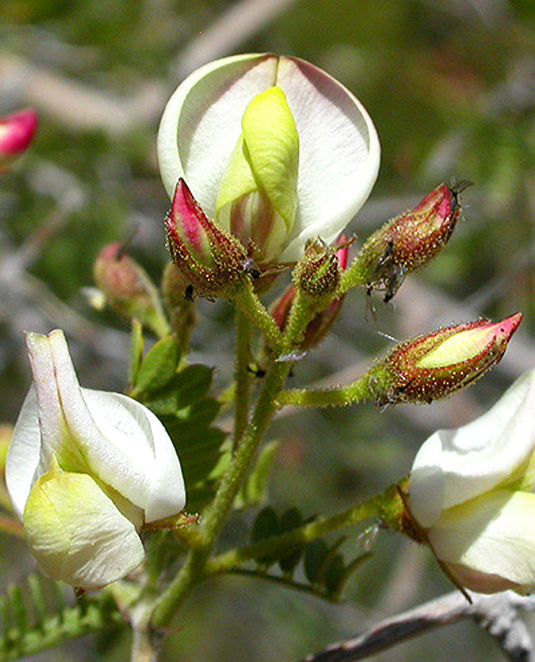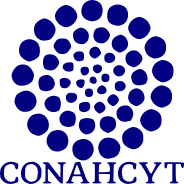Evaluation of the establishment of the sámota bush (Coursetia glandulosa A. Gray) from seeds, under different conditions in degraded arid land of Hermosillo, Sonora, México
DOI:
https://doi.org/10.18387/polibotanica.59.8Keywords:
Desertification, Livestock, Ranch management, Ecological successionAbstract
The objective of this work was to evaluate the effect of germination, survival, and growth of the first year, of the native forage shrub Coursetia glandulosa, from seeds sown in different conditions of degraded land and as a control in agricultural soil with drip irrigation in Hermosillo, Sonora, Mexico. 100 seeds were established in each patch of degraded soil: bare, bare soil adding pruning branches, under tree, and with protective plastic mesh, only at the expense of precipitation, in addition to control treatment patches in agricultural ecosystem where irrigation was applied. drip. The results after one year show that the highest germination was in the control treatment with irrigation and in the bare soil patches with mesh protection (44% and 40% germination respectively, χ² = 76.34, p = 0.0032). The one-year survival was higher in the agricultural ecosystem with 86.36% (χ² = 41.02, p = 0.0001) followed by 50% in the bare soil protected with mesh and 20% in the bare soil covered with branches, there was no one-year survival of the plants that were born under a tree and on bare soil. Plant growth was greater in the control treatment under irrigation, both in height and width of the leaf canopy, exceeding 150 cm and 145 cm respectively per year (p < 0.0001), while in the degraded ecosystem both with meshes as with branches the growths were less than 42 cm high and 10 cm wide. The establishment of C. glandulosa in arid degraded lands in northwest Mexico is far below its potential, limited by soil water availability and herbivory.
References
Allen, E. B., Roundy, B. A., McArthur, E. D., & Haley, J. S. (1995). Restoration ecology: limits and possibilities in arid and semiarid lands. In Proceedings of the Wildland Shrub and Arid Land Restoration Symposium (pp. 7-15). USDA Forest Service Intermountain Research Station General Technical Report INT-315.
Bonner, F. T., & Karrfalt, R. P. (2008). The woody plant seed manual. Agric. Handbook No. 727. Washington, DC. US Department of Agriculture, Forest Service, 1223 p. https://www.fs.fed.us/rm/pubs_series/wo/wo_ah727.pdf
Bowers, J. E., Turner, R. M., & Burgess, T. L. (2004). Temporal and spatial patterns in emergence and early survival of perennial plants in the Sonoran Desert. Plant Ecology, 172(1), 107–119. https://doi.org/10.1023/B:VEGE.0000026026.34760.1b
Camou, H. E. (1998). De rancheros, poquiteros, orejanos y criollos: los productores ganaderos de Sonora y el mercado internacional. El Colegio de Michoacán AC.
Canfield, R. H. (1941). Application of the line interception method in sampling range vegetation. Journal of Forestry, 39(4), 388-394. https://doi.org/10.1093/jof/39.4.388
Celaya-Michel, H., Hinojo-Hinojo, C., Celaya-Rosas, M., Valdez-Zamudio, D., y Rueda-Puente, E. O. (2020). Plantas nativas más comunes de las zonas áridas de Sonora. Universidad de Sonora. Colección de Textos académicos. Hermosillo Sonora. 255 p. https://libros.unison.mx/index.php/unison/catalog/book/41
Celaya-Michel, H., Mc Caughey-Espinoza, D. M., Rodríguez, J. C., Bautista-Olivas, A. L., Castellanos-Villegas, A. E., Hinojo-Hinojo, C., ... & Barrera-Silva, M. (2019). Post-transplantat performance of 17 native wood fodder species from Sonora, Mexico. Agrociencia (Montecillo), 53(3), 371-380. https://www.agrociencia-colpos.org/index.php/agrociencia/article/view/1790
CESAVE - SIAFESON (2022). Red de Estaciones Meteorológicas Automáticas de Sonora. https://www.siafeson.com/remas/
CONAGUA. (2014). Estadísticas del Agua en México, edición 2014. SEMARNATCONAGUA. México, D. F. 241 p.
D’Odorico, P., Bhattachan, A., Davis, K. F., Ravi, S., & Runyan, C. W. (2013). Global desertification: Drivers and feedbacks. Advances in water resources, 51, 326-344. https://doi.org/10.1016/j.advwatres.2012.01.013
Felger, R. S., Johnson, M. B., & Wilson, M. F. (2001). The trees of Sonora, Mexico. Oxford University Press.
Holechek J.L., Pieper R.D., Herbel C.H. (1995). Range Management, Principles and Practices. Prentice Hall, Englewood Cliffs, NJ, USA.
INEGI. (2014). Anuario estadístico y geográfico de Sonora 2014. Instituto Nacional de Estadística y Geografía. México. 611p. https://www.inegi.org.mx/contenidos/productos/prod_serv/contenidos/espanol/bvinegi/productos/integracion/pais/aepef/2014/702825063986.pdf
Infante, G. S., y Zarate de Lara, G. P. (2000). Métodos estadísticos: un enfoque interdisciplinario. Sexta reimpresión. Editorial Trillas. México. 643 p. https://biblioteca.ecosur.mx/cgi-bin/koha/opac-detail.pl?biblionumber=000000550
Martín, R. M. H., Ibarra, F. F. A., Moreno, M. S., & Ibarra, M. F. A. (2017). Transplanting brush species for the rehabilitation of Sonoran Desert degraded rangelands in Mexico. Grassland resources for extensive farming systems in marginal lands: major drivers and future scenarios, volumen 22 de Grassland Science in Europe, 363. https://www.academia.edu/download/56284196/EGFGrassland_resources_for_extensive_farming_systems_in_marginal_lands.pdf#page=388
Martín-Rivera, M., Ibarra-Flores, F., Guthery, F. S., Kublesky, W. P., Camou-Luders, G., Fimbres-Preciado J., y Johnson-Gordon, D. (2001). Habitat improvement for wildlife in north-central Sonora, Mexico. In: McArthur, E. D., y Daniel, J. (comps.) Shrubland ecosystem genetics and biodiversity: proceedings; 2000 June 13-15; Provo, UT. Proc. RMRS-P-21. Ogden, UT: US Department of Agriculture, Forest Service, Rocky Mountain Research Station. 21, pp 356-360. https://www.fs.usda.gov/treesearch/pubs/44617
MEA. Millennium Ecosystem Assessment. (2005). Ecosystems and human well-being: opportunities and challenges for business and industry. World Resources Institute, Washington, D. C.
Ochoa-Meza, A., Montiel-González, C., Ruelas-Islas, J. D. R., Barrera-Silva, M. A., Valdez-Domínguez, R. D., & Celaya-Michel, H. (2022). Germination and growth of the Sonoran Desert native trees under different agricultural conditions. Agroproductividad, 15(8). https://doi.org/10.32854/agrop.v15i8.2089
SAS. (2000). SAS statistical software. Version 5. SAS Institute. Cary, NC, USA. 254p. https://books.google.es/books
Turner, R. M., Bowers, J. E., & Burgess, T. L. (2005). Sonoran Desert plants: an ecological atlas. University of Arizona Press.
Velázquez J., C. (1997). Importancia y Valor Nutricional de las Especies Forrajeras de Sonora. Editorial UniSon. Hermosillo, México. 106 p.
Whitford, W. G. (2002) Ecology of Desert Ecosystems. Elsevier Science Ltd. London, UK. San Diego, CA, USA. 343p. https://books.google.com/books
WRB, IWG. (2015). World reference base for soil resources 2014, update 2015. World Soil Resources Reports. No. 106. FAO. Rome, Italy. 192p. https://www.fao.org/3/i3794en/I3794en.pdf

Downloads
Published
Issue
Section
License

Polibotánica by Departamento de Botánica de la Escuela Nacional de Ciencias Biológicas del Instituto Politécnico Nacional se distribuye bajo una Licencia Creative Commons Atribución-NoComercial-CompartirIgual 4.0 Internacional.



















